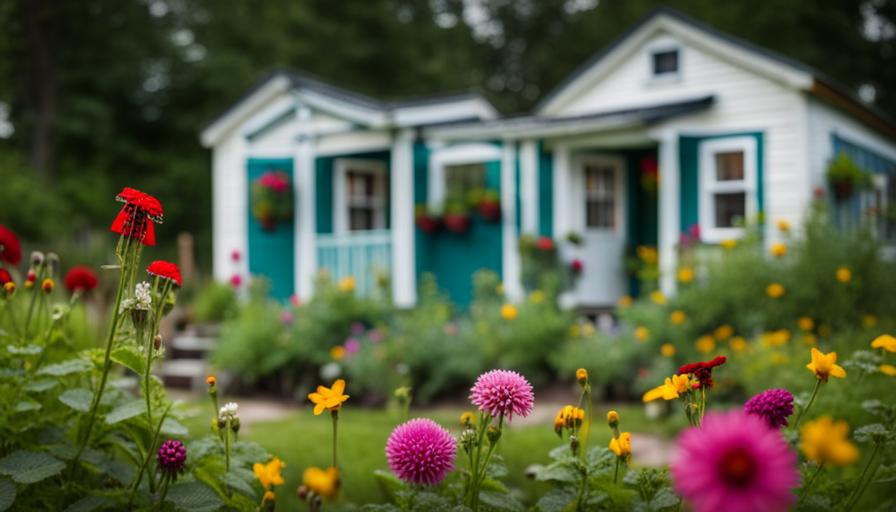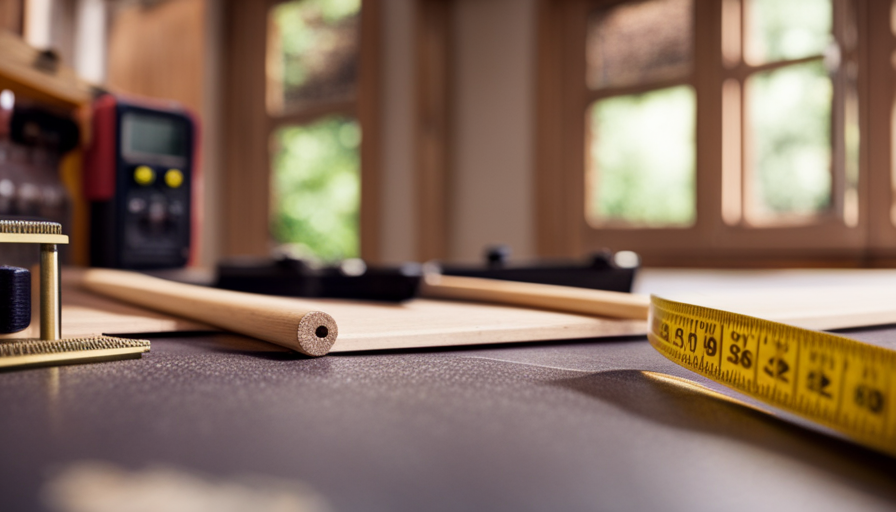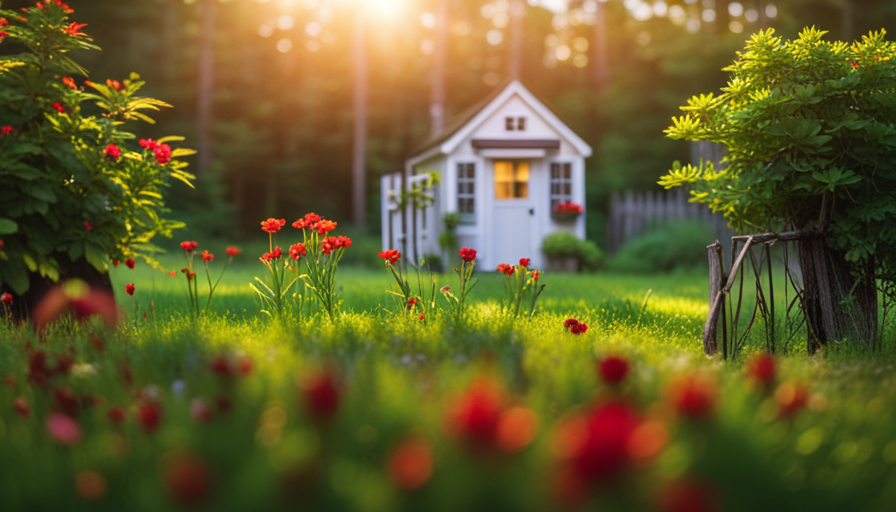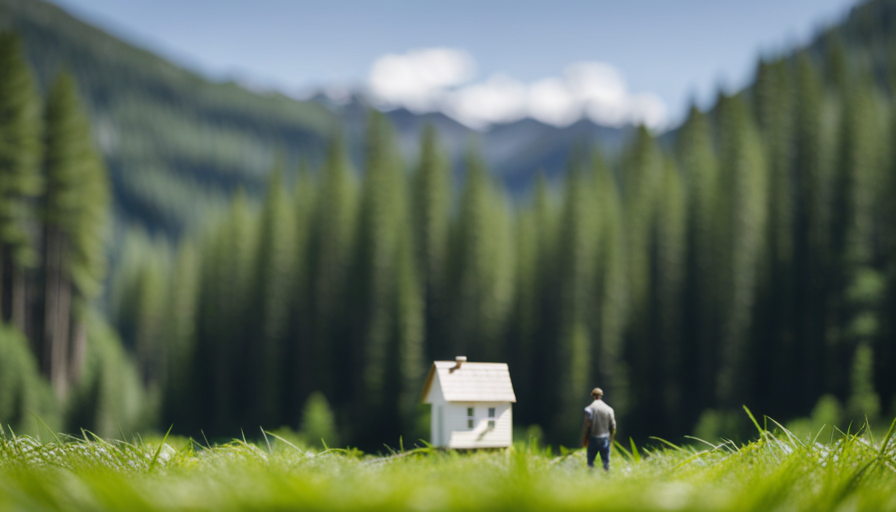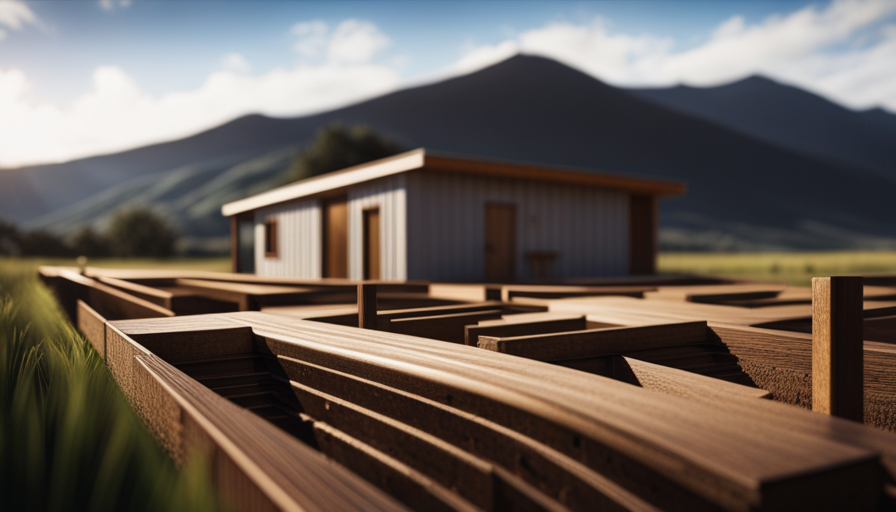Imagine a scenario where you can break free from the restrictions of traditional homeownership and find freedom in a tiny house. These small, environmentally friendly dwellings offer a simplified lifestyle, allowing you to focus on what truly matters. And what if you could actually get a tiny house for free? Yes, you read that right – a tiny house at absolutely no cost.
In this article, I will guide you through the journey of acquiring your very own free tiny house. From researching giveaway contests to exploring government programs and grants, there are numerous avenues to explore. You can even volunteer for tiny house building projects or join online communities that share your passion.
So, let’s dive in and discover the secrets to obtaining a free tiny house that will unlock a world of possibilities.
Key Takeaways
- Government programs and grants, such as Rural Housing Repair and HOME Investment Partnerships, can help individuals obtain affordable housing, including free tiny houses.
- Crowdfunding campaigns can be used to raise funds for a tiny house project.
- Volunteering for tiny house building projects, such as with Habitat for Humanity, can provide valuable experience and contribute to affordable housing options.
- Online communities and forums dedicated to tiny houses offer resources, tips, and support for building and living in a tiny house.
Research Tiny House Giveaway Contests
To increase your chances of acquiring a free tiny house, it’s advisable to research various tiny house giveaway contests. These contests are a great way to potentially win a fully furnished and ready-to-live-in tiny house. When researching these contests, be sure to look for ones that align with your preferences and needs.
Some contests may require specific criteria, such as submitting a design concept or sharing your story of why you deserve a tiny house. During your research, you may come across valuable resources and tips on tiny house design. Take advantage of these opportunities to learn about innovative space-saving solutions and creative storage ideas.
Additionally, it’s important to consider the pros and cons of living in a tiny house. While tiny houses offer financial freedom, minimalism, and a smaller carbon footprint, they also come with challenges such as limited space and potential zoning restrictions.
Once you have gathered information on tiny house giveaway contests and familiarized yourself with tiny house design tips and the pros and cons of living in a tiny house, it’s time to explore government programs and grants. These programs can provide financial assistance or resources to help you obtain a free or affordable tiny house.
Explore Government Programs and Grants
Did you know there are government programs and grants available for individuals looking to secure their own compact living space? When it comes to getting a free tiny house, exploring government funding options should not be overlooked. Many government agencies offer programs and grants specifically designed to help people build or obtain affordable housing, including tiny houses. These programs can provide financial assistance, technical support, and resources to help you navigate the process of building or acquiring a tiny house.
To give you an idea of the available options, here is a table showcasing some government programs and grants that can help you in your quest for a free tiny house:
| Program/Grant Name | Agency/Organization | Description |
|---|---|---|
| Rural Housing Repair | USDA | Provides grants to low-income individuals for home repairs. |
| HOME Investment Partnerships | HUD | Offers grants to eligible organizations for affordable housing projects. |
| Self-Help Homeownership | USDA | Assists low-income individuals in building their own homes. |
In addition to government funding, another option to explore is crowdfunding campaigns. Many individuals have successfully raised funds for their tiny houses through online platforms. These campaigns allow people to contribute small amounts of money towards your project, making it possible to finance your tiny house without relying solely on government assistance.
Now, let’s transition into the next section and look at tiny house exchange programs.
Look for Tiny House Exchange Programs
One option worth considering is exploring tiny house exchange programs to find affordable and unique living arrangements. These programs allow individuals to rent or exchange their tiny homes with others, giving you the opportunity to experience living in different locations without the burden of purchasing a house outright.
Tiny house rental options can be found through various online platforms and communities dedicated to promoting sustainable living and alternative housing options. This is a great way to test out the tiny house lifestyle before committing to building or buying your own.
In addition to rental options, some tiny house exchange programs also offer financing alternatives. These programs can help you secure a tiny house loan or provide assistance in finding funding options that fit your budget. By participating in these programs, you can not only find a place to live but also gain access to resources and support networks that can help you navigate the world of tiny house living.
As you explore tiny house exchange programs and rental options, you may also come across opportunities to volunteer for tiny house building projects. This can be a valuable experience for those interested in learning more about construction and design, while also giving back to the tiny house community. By getting involved in these projects, you can contribute your skills and time towards creating affordable housing options for others.
Volunteer for Tiny House Building Projects
You can contribute your time and skills to volunteer for building projects in the tiny house community, where individuals create affordable housing options for others, fostering a sense of community and shared resources. One way to get involved is by participating in tiny house building workshops. These workshops provide hands-on experience and guidance from experts in the field. Not only will you learn valuable construction skills, but you will also have the opportunity to connect with like-minded individuals who share your passion for tiny houses.
Another option is to volunteer for Habitat for Humanity projects that focus on constructing tiny houses. Habitat for Humanity is a well-known organization dedicated to providing affordable housing for those in need. By volunteering with them, you can directly contribute to the construction of tiny houses and make a positive impact on someone’s life.
To give you a deeper insight into the benefits of volunteering for tiny house building projects, here is a comparison table:
| Tiny House Building Workshops | Habitat for Humanity Projects |
|---|---|
| Learn construction skills | Help provide housing options |
| Connect with like-minded individuals | Make a direct impact on someone’s life |
| Hands-on experience | Join a well-known organization |
By volunteering for these projects, you not only gain valuable knowledge and skills, but you also become part of a larger community that is committed to creating affordable housing solutions. After exploring the world of tiny house building projects, it’s time to transition into the next section about joining online tiny house communities and forums.
Join Online Tiny House Communities and Forums
Immerse yourself in the world of tiny houses by joining online communities and forums where like-minded individuals share their experiences and expertise. Online networking is an invaluable resource when it comes to building and living in a tiny house.
These communities provide a platform for you to connect with others who have already gone through the process, allowing you to learn from their successes and challenges. Finding resources is another major benefit of joining these online communities. Members often share tips and tricks for sourcing materials, finding affordable land, and navigating legal regulations. You can also discover innovative design ideas and creative storage solutions that you may not have considered before.
In addition to the wealth of knowledge, online communities and forums offer a sense of camaraderie and support. It’s reassuring to know that there are others out there who share your passion for tiny houses and are willing to offer guidance along the way.
By joining these online platforms, you can gain valuable insights into the tiny house movement and connect with individuals who can help you achieve your goal of living in a tiny house. Consider house sitting or property caretaking opportunities as another avenue towards your dream.
Consider House Sitting or Property Caretaking Opportunities
By exploring house sitting or property caretaking opportunities, individuals can experience the joy of living in a cozy, low-maintenance space while taking care of someone else’s cherished home. House sitting involves temporarily living in a vacant house and looking after it while the owners are away. Property caretaking, on the other hand, may involve staying in a small cottage or cabin on a property and taking care of general maintenance tasks. Both options provide a unique opportunity to live in a tiny house without the financial commitment.
To find house sitting or property caretaking opportunities, there are various online platforms and websites dedicated to connecting homeowners with responsible individuals. These platforms allow you to create a profile, specify your preferences, and browse through available listings. It’s important to carefully read the listings and communicate with the homeowners to ensure a good fit for both parties.
House sitting and property caretaking can be a win-win situation. Homeowners have peace of mind knowing that their property is being cared for, while individuals get to enjoy the benefits of living in a tiny house without the cost. These experiences also offer a chance to explore different locations and lifestyles, making them ideal for those who crave adventure and flexibility.
As you consider house sitting or property caretaking, it’s worth exploring other alternative housing options that can further enhance your quest for a free tiny house.
Explore Alternative Housing Options
Take a moment to explore other unique housing options that can add excitement and diversity to your search for a cozy, low-maintenance dwelling. Did you know that according to a recent study, there’s been a 66% increase in the number of people opting for alternative housing solutions in the past decade?
One popular alternative housing option is the tiny house. These small, compact dwellings aren’t only environmentally friendly, but they also offer a chance to live a simpler, more minimalist lifestyle. Tiny house design trends have evolved over the years, making these homes both functional and aesthetically pleasing. From clever storage solutions to innovative space-saving designs, there are endless possibilities for customizing your tiny house to fit your needs.
Additionally, living in a tiny house has numerous advantages. They’re not only more affordable than traditional homes, but they also require less maintenance, allowing you to spend more time pursuing your passions and less time on household chores. If you’re interested in exploring alternative housing options, consider the advantages of living in a tiny house.
The next step is to connect with local nonprofit organizations that specialize in providing affordable housing solutions.
Connect with Local Nonprofit Organizations
If you’re looking to explore alternative housing options, connecting with local nonprofit organizations can be a great way to get a free tiny house. These organizations often have partnerships with local businesses and individuals who are willing to donate or sponsor tiny houses for those in need.
By reaching out to these organizations, you can tap into their network and resources to find opportunities for free or heavily discounted tiny houses. One of the ways these partnerships work is through fundraising events. Nonprofit organizations often organize events such as auctions, galas, or community gatherings to raise funds for their causes.
Attending these events not only supports the organization but also gives you a chance to meet potential sponsors or donors who might be interested in providing a tiny house. Additionally, these events can be a great way to learn more about the tiny house community and connect with like-minded individuals.
To help you visualize the possibilities, here are three examples of how local partnerships and fundraising events can lead to a free tiny house:
-
Local construction companies team up with nonprofit organizations to build and donate tiny houses to individuals in need.
-
Community members come together to organize a charity auction, with the proceeds going towards funding a tiny house for someone who can’t afford one.
-
Local businesses sponsor tiny house building workshops, where participants have the opportunity to win a fully constructed tiny house.
By connecting with local nonprofit organizations and attending fundraising events, you can increase your chances of finding a free tiny house. But that’s not the only way! In the next section, we’ll explore how you can utilize social media and online marketplaces to further your search for a free tiny house.
Utilize Social Media and Online Marketplaces
Harness the power of social media and online marketplaces to uncover incredible opportunities in your quest for a cozy, affordable living space. When it comes to tiny house construction and financing, there are plenty of resources available online that can help you find the perfect tiny house for free or at a low cost.
Social media platforms like Facebook and Instagram have groups and pages dedicated to tiny house enthusiasts. Joining these communities can connect you with people who are looking to give away or sell their tiny houses at a discounted price. Additionally, online marketplaces such as Craigslist and Tiny House Listings allow you to browse through a variety of tiny houses for sale or even trade.
When searching online, be sure to use specific keywords like ‘free tiny house’ or ‘affordable tiny house’ to narrow down your options. You can also reach out to local tiny house builders and ask if they have any discounted or giveaway opportunities available.
By utilizing social media and online marketplaces, you can find unique and affordable tiny house options that fit your needs and budget. Don’t forget to get creative with DIY tiny house building and repurposing, as we will explore in the next section.
So, let’s dive into the world of DIY tiny house construction and repurposing to further enhance your chances of getting a free tiny house.
Get Creative with DIY Tiny House Building and Repurposing
Embrace your creativity and explore the world of DIY construction and repurposing to transform ordinary materials into your dream living space, proving that building a cozy, affordable home doesn’t have to be limited to traditional methods. When it comes to decorating your tiny house, the possibilities are endless. Whether you prefer a minimalist, rustic, or eclectic style, there are plenty of ideas to make the most of your limited space.
To help you get started, here are some tiny house decoration ideas:
| Decorating Ideas | Description | Benefits |
|---|---|---|
| Vertical storage solutions | Utilize vertical space by installing shelves or hanging organizers. | Maximizes storage space and keeps your tiny house organized. |
| Multi-functional furniture | Choose furniture pieces that serve multiple purposes, such as a sofa with built-in storage or a desk that transforms into a dining table. | Saves space and maximizes functionality. |
| Natural light and mirrors | Use large windows and strategically placed mirrors to create the illusion of a bigger space and let more natural light in. | Makes your tiny house feel bright and airy. |
When it comes to financing your tiny house project, there are several options to consider. You can explore personal loans, RV loans, or even crowdfunding platforms specifically designed for alternative housing projects. Additionally, some tiny house builders offer financing options or rent-to-own programs.
Remember, building a tiny house is not only about saving money but also about expressing your creativity and personal style. So, get inspired, think outside the box, and turn your tiny house into a cozy and unique home that reflects your personality.
Frequently Asked Questions
Are there any restrictions on who can participate in tiny house giveaway contests?
Participation restrictions and eligibility criteria can vary for each tiny house giveaway contest. Some contests may have age restrictions, requiring participants to be at least 18 years old.
Others may have residency restrictions, limiting participation to certain regions or countries.
Additionally, some contests may require participants to meet specific income or financial criteria.
It’s important to carefully review the rules and regulations of each contest to determine if you’re eligible to participate.
How can I find out if I qualify for government programs and grants for tiny house ownership?
To find out if you qualify for government programs and grants for tiny house ownership, start by researching the specific requirements set by these programs.
Look for information on government websites, local housing authorities, or contact relevant organizations for guidance.
Some factors that may determine eligibility include income level, location, and housing needs.
It’s important to thoroughly review the qualifications to ensure you meet the criteria before applying for any grants or government assistance for your tiny house.
What are the requirements to participate in a tiny house exchange program?
To participate in a tiny house exchange program, there are certain requirements and eligibility restrictions.
While you may think it’s difficult to meet these criteria, it’s actually quite feasible. The participating requirements typically include having a stable income, a good credit score, and a willingness to maintain the property. Additionally, some programs may have restrictions based on location or age.
By meeting these criteria, you can take advantage of the benefits and opportunities offered by a tiny house exchange program.
How can I ensure the safety and legality of volunteering for tiny house building projects?
To ensure the safety and legality of volunteering for tiny house building projects, it’s important to take certain precautions.
First, conduct background checks on all participants to ensure a safe environment.
Additionally, have volunteers and the organization sign liability waivers to protect everyone involved.
These measures help ensure that everyone is qualified and protected, creating a secure and legal environment for volunteering in tiny house building projects.
What are some alternative housing options to consider besides tiny houses?
Living in a world where housing costs are soaring, considering alternative options can be a breath of fresh air.
Container homes, for instance, provide an eco-friendly and affordable solution. These homes, made from recycled shipping containers, can be customized to suit your needs.
Another option is co-housing communities, where individuals share common spaces and resources, creating a sense of community and reducing costs.
Exploring these alternatives can open up a world of affordable and sustainable housing opportunities.
Conclusion
In conclusion, getting a free tiny house is not an impossible dream. By researching giveaway contests, exploring government programs and grants, participating in exchange programs, and volunteering for building projects, you can increase your chances of finding a free tiny house.
Additionally, utilizing social media, online marketplaces, and getting creative with DIY projects can also be helpful. Remember, where there’s a will, there’s a way, so don’t give up on your dream of owning a tiny house. As the saying goes, "Where there’s a door, there’s a home."
Hi, I’m Emma. I’m the Editor in Chief of Tiny House 43, a blog all about tiny houses. While tree houses are often associated with childhood, they can be the perfect adult retreat. They offer a cozy space to relax and unwind, surrounded by nature. And since they’re typically built on stilts or raised platforms, they offer stunning views that traditional homes simply can’t match. If you’re looking for a unique and romantic getaway, a tree house tiny house might just be the perfect option.
